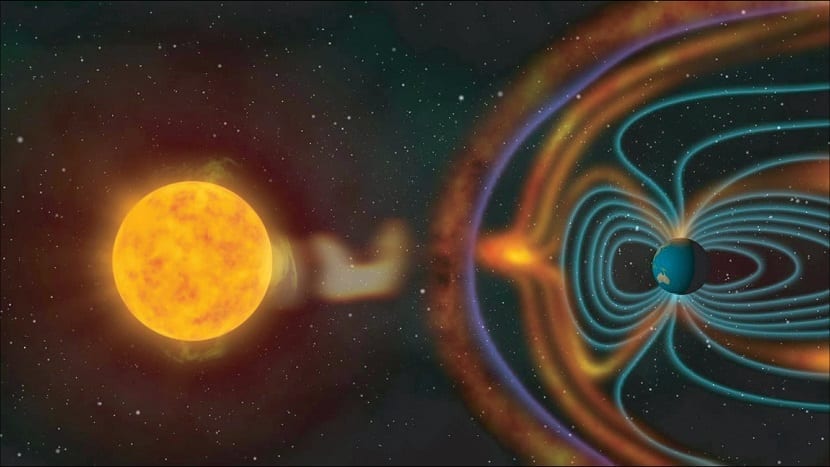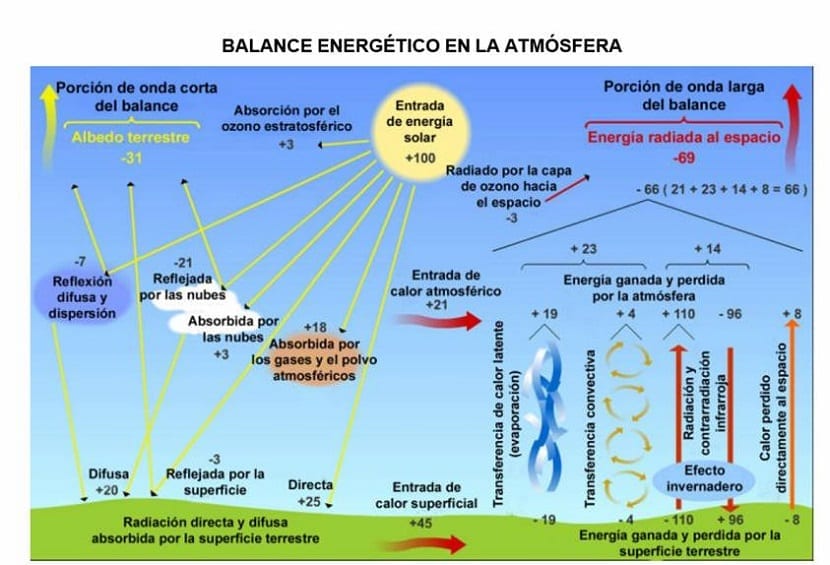
Solar radiation is an important meteorological variable that serves to know the amount of "heat" that we will receive from the sun on the earth's surface. This amount of solar radiation is being altered by climate change and the retention of greenhouse gases.
Solar radiation is capable of heating the surface of the ground and objects (even ours) with hardly heating the air. Furthermore, this variable is very important in order to evaluate the work we are doing in the fight against climate change. Do you want to know everything about solar radiation?
Solar radiation passes through the atmosphere

When we are at the beach on one of these hot summer days, we lie down "to the sun." As we stay in the towel for longer, we notice how our body warms up and increases its temperature, until we need to take a bath or get in the shade because we get burned. What has happened here, if the air is not so hot? What has happened is that the sun's rays have passed through our atmosphere and have warmed our bodies with hardly any heating of the air.
Something similar to what happens to us in this situation is what happens to the Earth: The atmosphere is almost 'transparent' to solar radiation, but the Earth's surface and other bodies located on it do absorb it. The energy transferred by the Sun to the Earth is what is known as radiant energy or radiation. Radiation travels through space in the form of waves that carry energy. Depending on the amount of energy they carry, they are classified along the electromagnetic spectrum. We have the most energetic waves such as gamma rays, X rays and ultraviolet, as well as those with less energy such as infrared, microwaves and radio waves.
All bodies emit radiation

All bodies emit radiation based on their temperature. This is given by Stefan-Boltzmann's law which states that the energy emitted by a body is directly proportional to the fourth power of its temperature. This is why both the Sun, a burning piece of wood, our own body and even a piece of ice are radiating energy in a continuous way.
This leads us to ask ourselves a question: why are we able to "see" the radiation that is emitted by the sun or the burning piece of wood and we are not able to see the radiation that we emit, the surface of the Earth or the piece of ice? As well, this depends largely on the temperature reached by each of them, and therefore, the amount of energy that they predominantly emit. The more temperature the bodies reach, the greater the amount of energy they emit in their waves, and that is why they will be more visible.
The Sun is at a temperature of 6.000 K and emits radiation mainly in waves of the visible range (generally known as light waves), it also emits ultraviolet radiation (which has more energy and that is why it burns our skin in long exposures) and the The rest it emits is infrared radiation that is not perceived by the human eye. That is why we cannot perceive the radiation that our body emits. The human body is at about 37 degrees Celsius and the radiation it emits is in the infrared.
How solar radiation works

Surely knowing that bodies are continuously emitting radiation and energy will bring another question to your head. Why, if bodies emit energy and radiation, don't they gradually cool down? The answer to this question is simple: while they are emitting energy, they are also absorbing it. There is another law, which is that of radiative balance, which says that an object emits the same amount of energy as it absorbs, that is why they are able to maintain a constant temperature.
Thus, in our earth-atmosphere system a series of processes take place in which energy is absorbed, emitted and reflected, so that the final balance between the radiation that reaches the top of the atmosphere from the Sun and that which goes out into outer space is zero. In other words, the average annual temperature remains constant. When solar radiation enters the Earth, most of it is absorbed by the Earth's surface. Very little of the incident radiation is absorbed by clouds and air. The rest of the radiation is reflected by the surface, gases, clouds and is returned to outer space.
The amount of radiation that is reflected by a body in relation to the incident radiation is known as 'albedo'. Therefore, we can say that the earth-atmosphere system has an average albedo of 30%. Newly fallen snow or some highly vertically developed cumulonimbus have an albedo close to 90%, while deserts have around 25% and the oceans around 10% (they absorb almost all the radiation that reaches them).
How do we measure radiation?

To measure the solar radiation that we receive at a point, we use a device called a pyranometer. This section consists of a sensor enclosed in a transparent hemisphere that transmits all radiation of a very small wavelength. This sensor has alternating black and white segments that absorb the amount of radiation in a different way. The temperature contrast between these segments is calibrated according to the radiation flux (measured in watts per square meter).
An estimate of the amount of solar radiation we receive can also be obtained by measuring the number of hours of sunshine we have. To do this, we use an instrument called a heliograph. This is formed by a glass sphere oriented towards the geographical south, which acts as a large magnifying glass, concentrating all the radiation received in an incandescent point that burns a special paper tape graduated with the hours of the day.
Solar radiation and increased greenhouse effect

Earlier we mentioned that the amount of solar radiation that enters the Earth and that which leaves is the same. This is not entirely true, because if so, the global average temperature of our planet would be -88 degrees. We need something to help us retain heat to be able to have such a pleasant and habitable temperature that makes life possible on the planet. That is where we introduce the greenhouse effect. When solar radiation hits the Earth's surface, it returns almost half back to the atmosphere to expel it into outer space. Well, we have commented that clouds, air and other atmospheric components absorb a small part of solar radiation. However, this amount absorbed is not enough to be able to maintain a stable temperature and make our planet habitable. How can we live with these temperatures?
The so-called greenhouse gases are those gases that retain part of the temperature emitted by the earth's surface that returns back to the atmosphere. Greenhouse gases are: water vapor, carbon dioxide (CO2), nitrogen oxides, sulfur oxides, methane, etc. Each greenhouse gas has a different ability to absorb solar radiation. The more capacity it has to absorb radiation, the more heat it will retain and will not allow it to return to outer space.

Throughout human history, the concentration of greenhouse gases (including the most CO2) has been increasing more and more. The rise of this increase is due the industrial revolution and the burning of fossil fuels in industry, energy and transport. The burning of fossil fuels such as oil and coal, cause CO2 and methane emissions. These gases in an increasing emission cause them to retain a large amount of solar radiation and do not allow it to be returned to outer space.
This is known as the greenhouse effect. However, increasing this effect we call greenhouse it's counterproductive, since what we are doing is increasing global average temperatures more and more. The more concentration of these radiation-absorbing gases in the atmosphere, the more heat they will retain and, therefore, the higher the temperatures will rise.
Solar radiation and climate change
Global warming is known worldwide. This increase in temperatures due to the great retention of solar radiation causes a change in the global climate. It not only means that the average temperatures of the planet will increase, but that the climate and everything that entails will change.
The increase in temperatures causes destabilization in the air currents, oceanic masses, species distribution, succession of the seasons, increase in extreme meteorological phenomena (such as droughts, floods, hurricanes ...), etc.. That is why in order to regain our radiative balance in a stable way, we have to reduce greenhouse gas emissions and regain our climate.